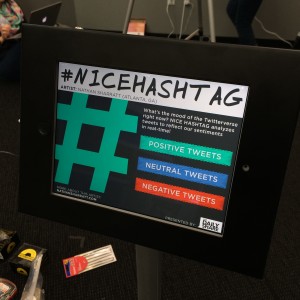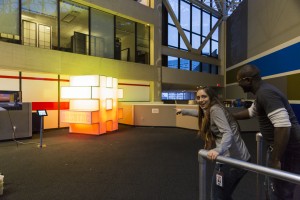#nicehashtag – Building a data-driven sculpture
Since early fall 2014 I’ve been working on a data-driven sculpture for HLN called “#nicehashtag” that is now installed in the CNN World Headquarters in here in Atlanta (if you take the Inside CNN tour you’ll see it outside Studio 7).
Programmable Hue bulbs change color to reflect realtime sentiment analysis of Twitter. The algorithm accesses Twitter every few seconds and pulls the most recent tweet into its program, determines whether the tweet is positive, neutral, or negative, then compares it to previous tweets and converts it into a percentage that it stores in memory. When that percentage reaches a certain threshold, the color changes.

My goal with this project was to consider how we use technology to interact with each other, and how that affects our emotional connections. Screens have enhanced and expanded our communication capabilities enormously, but there are still concerns about what it does to our ability to empathize with others. #nicehashtag is a physical representation of internet emotion, at least within the Twitterverse.
The challenge with any technologically-enhanced artwork is that the novelty of the tech will overpower the concept that (hopefully) supports it. Using tech in art just because it’s there is seductive but also dangerous for the above reason.
Here are some behind-the scenes pictures:
- The frame is steel, the blue is the protective film on the white acrylic.
- In the thick of production.
- The letters were laser-cut.
- The “hashtag” panel with letters glued on.
- The front vertical panels are the largest sections, at 8′ high.
- The lights were attached with simple worklamp clamps.
- Designing the optimal placement was a challenge to get the most even lighting.
- After two all-nighters, we got the frame to CNN.
- Installing outside Studio 7, with programmer Miles working on debugging the code.
- The lights are broken up into 5 rows, controlled separately. Here, we tested the lights by setting rows of lights to different colors.
- The final sculpture in positive/neutral state.
- #nicehashtag



















